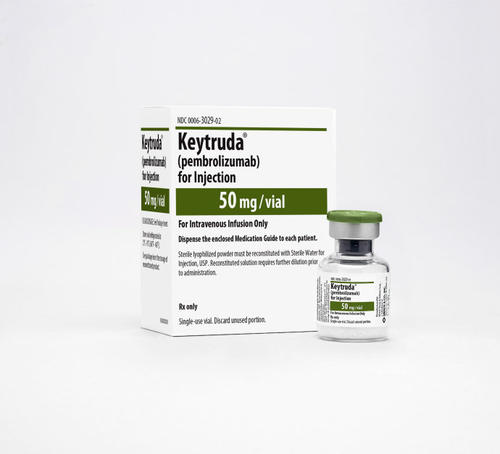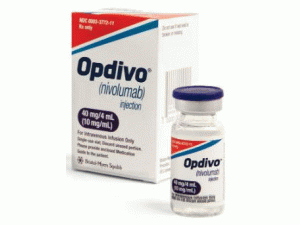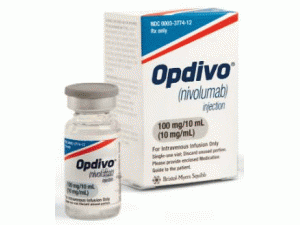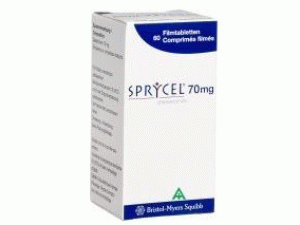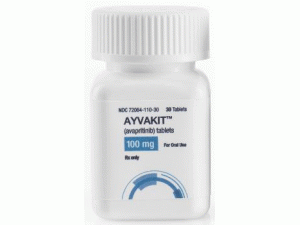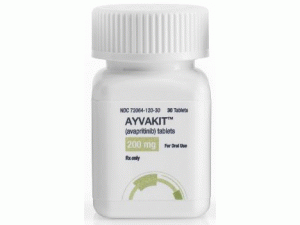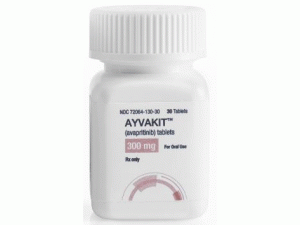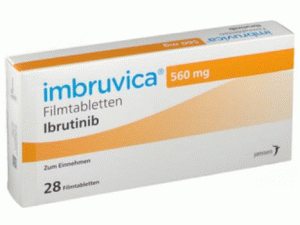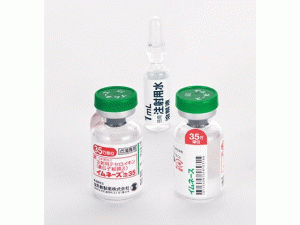塞替派注射粉剂TEPADINA (powder infusion)说明书
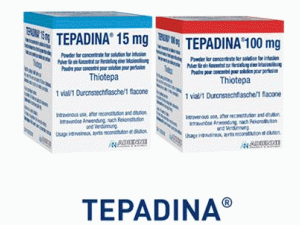 药店国别:
产地国家:意大利
处 方 药:是
所属类别:100毫克/10毫升(10毫克/毫升)/瓶
包装规格:100毫克/10毫升(10毫克/毫升)/瓶
计价单位:瓶
生产厂家中文参考译名:ADIENNE S.r.l. S.U.
生产厂家英文名:ADIENNE S.r.l. S.U.
原产地英文商品名:TEPADINA powder solution infusion 100MG/10ML(10mg/ml)/VIAL
原产地英文药品名:THIOTEPA
中文参考商品译名:TEPADINA粉末溶液输注 100毫克/10毫升(10毫克/毫升)/瓶
中文参考药品译名:塞替派
曾用名:
简介:
部份中文塞替派处方资料(仅供参考)
临床应用:
主要用于治疗乳腺癌、卵巢癌、膀胱癌(局部灌注)及癌性体腔积液(腔内注射)等,也曾用于治疗原发性肝癌、子宫颈癌、黑色素瘤、胃肠道肿瘤等。
注意事项:
1、妊娠初期的3个月应避免使用此药,因其有致突变或致畸胎作用,可增加胎儿死亡及先天性畸形。
2、下列情况应慎用或减量使用:骨髓抑制、肝功能损害、感染、肾功能损害、肿瘤细胞浸润骨髓、有泌尿系结石史和痛风病史。
3、用药期间每周都要定期检查外周血象,白细胞与血小板及肝、肾功能。
停药后3周内应继续进行相应检查,已防止出现持续的严重骨髓抑制4、肝肾功能较差时,塞替派注射液应用较低的剂量。
5、在白血病、淋巴瘤病人中为防止尿酸性肾病或高尿酸血症,可给予大量补液(或)给予别嘌呤醇。
6、尽量减少与其它烷化剂联合使用,或同时接受放疗。
用法与用量:
静脉或肌肉注射(单一用药):一次10mg(0.2mg/kg)每日一次,连续5天后改为每周3次,一疗程总量300mg。
胸腹腔或心包腔内注射:一次10~30mg,每周1~2次。
膀胱腔内灌注:每次排空尿液后将导尿管插入膀胱内向腔内注入60mg,溶于生理盐水60ml,每周1~2次,10次为一疗程。
动脉注射:每次10~20mg用法同静脉。
禁忌症:
对塞替派注射液过敏者,有严重肝肾功能损害,严重骨髓抑制者
孕妇、哺乳期妇女用药注意事项
不向孕妇推荐此药,可能有致畸性。尚没有对受乳婴儿影响的报道。
不良反应:
骨髓抑制是最常见的剂量限制毒性,多在用药后l~6周发生,停药后大多数可恢复。有些病例在疗程结束时开始下降,少数病例抑制时间较长。可有食欲减退、恶心及呕吐等胃肠反应。
个别报道用此药后再接受手术麻醉时,用琥珀酰胆碱后出现呼吸暂停。少见过敏,个别有发热及皮疹。有少量报告有出血性膀胱炎,注射部位疼痛,头痛、头晕,闭经、影响精子形成。
药物相互作用:
1、塞替派可增加血尿酸水平,为了控制高尿酸血症可给予别嘌呤醇。
2、与放疗同时应用时,应适当调整剂量。
3、与琥珀胆碱同时应用可使呼吸暂停延长,在接受塞替派治疗的病人,应用琥珀胆碱前必须测定血中假胆碱酯酶水平。
4、与尿激酶同时应用可增加塞替派治疗膀胱癌的疗效,尿激酶为纤维蛋白溶酶原的活化剂,可增加药物在肿瘤组织中的浓度。
药理:
塞替派为细胞周期非特异性药物,在生理条件下,形成不稳定的亚乙基亚胺基,具有较强的细胞毒作用。塞替派是多功能烷化剂,能抑制核酸的合成,与DNA发生交叉联结,干扰DNA和RNA的功能,改变DNA的功能,故也可引起突变。
体外试验显示可引起染色体畸变,在小鼠的研究中可清楚看到有致癌性,但对人尚不十分清楚。近年来证明塞替派注射液对垂体促卵泡激素含量有影响。
药物代谢动力学:
塞替派注射液不宜从消化道吸收。注射后广泛分布在各组织内。1~4小时后血浆浓度下降90%,24~48小时大部分药物通过肾脏排出。注射药物后血浆蛋白结合率为10%,主要和白蛋白、脂蛋白结合,对白蛋白亲和力最大。T1/2约3小时。尚无资料说明药物能否通过胎盘屏障。
用药过量:
药物过量后没有解毒药物。以往出现骨髓毒性后建议输注全血或白细胞、血小板悬液。目前,白细胞下降可使用粒细胞集落刺激因子。
英语说明:
TEPADINA 100 mg powder for concentrate for solution for infusion
TEPADINA 100 mg powder for concentrate for solution for infusion
TEPADINA® 15mg/TEPADINA® 100 mg
Summary for the public
What is Tepadina?
Tepadina is a powder that is made up into a solution for infusion (drip into a vein). It contains the active substance thiotepa.
What is Tepadina used for?
Tepadina is used in combination with chemotherapy (medicines to treat cancer) in two ways:
as a ‘conditioning’ (preparative) treatment before transplantation of haematopoietic progenitor cells (the cells that make blood cells). This type of transplant is used in patients who need to replace their blood-making cells because they have a blood disease such as a cancer of the blood (including leukaemia) or diseases causing low red blood cell counts (including thalassaemia or sickle-cell anaemia);
during the treatment of solid tumours when high-dose chemotherapy followed by transplantation of haematopoietic progenitor cells is needed.
Tepadina can be used for transplantation of cells from a donor and for transplantation of cells derived from the patient’s own body.
Because the number of patients in the European Union (EU) that undergo this type of conditioning and transplant is low, Tepadina was designated an ‘orphan medicine’ (a medicine used in rare diseases) on 29 January 2007.
The medicine can only be obtained with a prescription.
How is Tepadina used?
Tepadina treatment must be supervised by a doctor who has experience in treatments given before transplantation. It must be given as an infusion into a large vein lasting two to four hours.
The dose of Tepadina depends on the type of blood disease or solid tumour that the patient has and the type of transplantation to be carried out. The dose also depends on the patient’s body surface area (calculated using the height and weight of the patient). In adults, the daily dose ranges from 120 to 481 mg per square metre (m2) given for up to five days before transplantation. In children, the daily dose ranges from 125 to 350 mg/m2 given for up to three days before transplantation. For further information, see the Summary of Product Characteristics (also part of the EPAR).
How does Tepadina work?
The active substance in Tepadina, thiotepa, belongs to a group of medicines called ‘alkylating agents’. These substances are ‘cytotoxic’. This means that they kill cells, especially cells that multiply rapidly, such as cancer or progenitor (or ‘stem’) cells (cells that can develop into different types of cell). Tepadina is used with other medicines before transplantation to destroy the abnormal cells and the patient’s existing blood-making cells. This allows new cells to be transplanted, by creating space for the new cells and reducing the risk of rejection.
Thiotepa has been used to prepare patients for transplantation of blood-making cells in the European Union (EU) since the late 1980s.
How has Tepadina been studied?
Because thiotepa has been used for many years in the EU, the company presented data from the published literature. This included 109 studies involving around 6,000 adults and 900 children with blood diseases or solid tumours, who were having a transplant of blood-making cells. The studies looked at the number of patients with successful transplantations, how long it took for the diseases to come back and how long the patients survived.
What benefit has Tepadina shown during the studies?
The published studies showed that thiotepa used in combination with other chemotherapy medicines is beneficial to adults and children being treated for blood diseases and solid tumours. It helps to destroy the patient’s existing blood-making cells, resulting in the successful transplantation of new cells, improved survival and a reduced risk of the diseases coming back.
What is the risk associated with Tepadina?
The most common side effects seen with Tepadina when used with other medicines are infections, cytopenia (low number of cells in the blood), graft-versus-host disease (when the transplanted cells attack the body), disorders of the gut, haemorrhagic cystitis (bleeding and inflammation in the bladder) and mucosal inflammation (inflammation of the moist body surfaces). For the full list of all side effects reported with Tepadina in adults and children, see the Package Leaflet.
Tepadina should not be used in people who may be hypersensitive (allergic) to thiotepa or any of the other ingredients. It must not be used in women who are pregnant or breast-feeding. It must also not be used together with the vaccine against yellow fever or vaccines containing live viruses or bacteria.
Why has Tepadina been approved?
The Committee for Medicinal Products for Human Use (CHMP) noted that the active substance in Tepadina, thiotepa, has a well established used. This means that it has been used for many years and that there was sufficient information on its effectiveness and safety. The Committee decided that, based on available published information, Tepadina’s benefits are greater than its risks and recommended that it be given marketing authorisation.
Other information about Tepadina:
The European Commission granted a marketing authorisation valid throughout the European Union for Tepadina to Adienne S.r.l. on 15 March 2010. The marketing authorisation is valid for five years, after which it can be renewed.
药店国别:
产地国家:意大利
处 方 药:是
所属类别:100毫克/10毫升(10毫克/毫升)/瓶
包装规格:100毫克/10毫升(10毫克/毫升)/瓶
计价单位:瓶
生产厂家中文参考译名:ADIENNE S.r.l. S.U.
生产厂家英文名:ADIENNE S.r.l. S.U.
原产地英文商品名:TEPADINA powder solution infusion 100MG/10ML(10mg/ml)/VIAL
原产地英文药品名:THIOTEPA
中文参考商品译名:TEPADINA粉末溶液输注 100毫克/10毫升(10毫克/毫升)/瓶
中文参考药品译名:塞替派
曾用名:
简介:
部份中文塞替派处方资料(仅供参考)
临床应用:
主要用于治疗乳腺癌、卵巢癌、膀胱癌(局部灌注)及癌性体腔积液(腔内注射)等,也曾用于治疗原发性肝癌、子宫颈癌、黑色素瘤、胃肠道肿瘤等。
注意事项:
1、妊娠初期的3个月应避免使用此药,因其有致突变或致畸胎作用,可增加胎儿死亡及先天性畸形。
2、下列情况应慎用或减量使用:骨髓抑制、肝功能损害、感染、肾功能损害、肿瘤细胞浸润骨髓、有泌尿系结石史和痛风病史。
3、用药期间每周都要定期检查外周血象,白细胞与血小板及肝、肾功能。
停药后3周内应继续进行相应检查,已防止出现持续的严重骨髓抑制4、肝肾功能较差时,塞替派注射液应用较低的剂量。
5、在白血病、淋巴瘤病人中为防止尿酸性肾病或高尿酸血症,可给予大量补液(或)给予别嘌呤醇。
6、尽量减少与其它烷化剂联合使用,或同时接受放疗。
用法与用量:
静脉或肌肉注射(单一用药):一次10mg(0.2mg/kg)每日一次,连续5天后改为每周3次,一疗程总量300mg。
胸腹腔或心包腔内注射:一次10~30mg,每周1~2次。
膀胱腔内灌注:每次排空尿液后将导尿管插入膀胱内向腔内注入60mg,溶于生理盐水60ml,每周1~2次,10次为一疗程。
动脉注射:每次10~20mg用法同静脉。
禁忌症:
对塞替派注射液过敏者,有严重肝肾功能损害,严重骨髓抑制者
孕妇、哺乳期妇女用药注意事项
不向孕妇推荐此药,可能有致畸性。尚没有对受乳婴儿影响的报道。
不良反应:
骨髓抑制是最常见的剂量限制毒性,多在用药后l~6周发生,停药后大多数可恢复。有些病例在疗程结束时开始下降,少数病例抑制时间较长。可有食欲减退、恶心及呕吐等胃肠反应。
个别报道用此药后再接受手术麻醉时,用琥珀酰胆碱后出现呼吸暂停。少见过敏,个别有发热及皮疹。有少量报告有出血性膀胱炎,注射部位疼痛,头痛、头晕,闭经、影响精子形成。
药物相互作用:
1、塞替派可增加血尿酸水平,为了控制高尿酸血症可给予别嘌呤醇。
2、与放疗同时应用时,应适当调整剂量。
3、与琥珀胆碱同时应用可使呼吸暂停延长,在接受塞替派治疗的病人,应用琥珀胆碱前必须测定血中假胆碱酯酶水平。
4、与尿激酶同时应用可增加塞替派治疗膀胱癌的疗效,尿激酶为纤维蛋白溶酶原的活化剂,可增加药物在肿瘤组织中的浓度。
药理:
塞替派为细胞周期非特异性药物,在生理条件下,形成不稳定的亚乙基亚胺基,具有较强的细胞毒作用。塞替派是多功能烷化剂,能抑制核酸的合成,与DNA发生交叉联结,干扰DNA和RNA的功能,改变DNA的功能,故也可引起突变。
体外试验显示可引起染色体畸变,在小鼠的研究中可清楚看到有致癌性,但对人尚不十分清楚。近年来证明塞替派注射液对垂体促卵泡激素含量有影响。
药物代谢动力学:
塞替派注射液不宜从消化道吸收。注射后广泛分布在各组织内。1~4小时后血浆浓度下降90%,24~48小时大部分药物通过肾脏排出。注射药物后血浆蛋白结合率为10%,主要和白蛋白、脂蛋白结合,对白蛋白亲和力最大。T1/2约3小时。尚无资料说明药物能否通过胎盘屏障。
用药过量:
药物过量后没有解毒药物。以往出现骨髓毒性后建议输注全血或白细胞、血小板悬液。目前,白细胞下降可使用粒细胞集落刺激因子。
英语说明:
TEPADINA 100 mg powder for concentrate for solution for infusion
TEPADINA 100 mg powder for concentrate for solution for infusion
TEPADINA® 15mg/TEPADINA® 100 mg
Summary for the public
What is Tepadina?
Tepadina is a powder that is made up into a solution for infusion (drip into a vein). It contains the active substance thiotepa.
What is Tepadina used for?
Tepadina is used in combination with chemotherapy (medicines to treat cancer) in two ways:
as a ‘conditioning’ (preparative) treatment before transplantation of haematopoietic progenitor cells (the cells that make blood cells). This type of transplant is used in patients who need to replace their blood-making cells because they have a blood disease such as a cancer of the blood (including leukaemia) or diseases causing low red blood cell counts (including thalassaemia or sickle-cell anaemia);
during the treatment of solid tumours when high-dose chemotherapy followed by transplantation of haematopoietic progenitor cells is needed.
Tepadina can be used for transplantation of cells from a donor and for transplantation of cells derived from the patient’s own body.
Because the number of patients in the European Union (EU) that undergo this type of conditioning and transplant is low, Tepadina was designated an ‘orphan medicine’ (a medicine used in rare diseases) on 29 January 2007.
The medicine can only be obtained with a prescription.
How is Tepadina used?
Tepadina treatment must be supervised by a doctor who has experience in treatments given before transplantation. It must be given as an infusion into a large vein lasting two to four hours.
The dose of Tepadina depends on the type of blood disease or solid tumour that the patient has and the type of transplantation to be carried out. The dose also depends on the patient’s body surface area (calculated using the height and weight of the patient). In adults, the daily dose ranges from 120 to 481 mg per square metre (m2) given for up to five days before transplantation. In children, the daily dose ranges from 125 to 350 mg/m2 given for up to three days before transplantation. For further information, see the Summary of Product Characteristics (also part of the EPAR).
How does Tepadina work?
The active substance in Tepadina, thiotepa, belongs to a group of medicines called ‘alkylating agents’. These substances are ‘cytotoxic’. This means that they kill cells, especially cells that multiply rapidly, such as cancer or progenitor (or ‘stem’) cells (cells that can develop into different types of cell). Tepadina is used with other medicines before transplantation to destroy the abnormal cells and the patient’s existing blood-making cells. This allows new cells to be transplanted, by creating space for the new cells and reducing the risk of rejection.
Thiotepa has been used to prepare patients for transplantation of blood-making cells in the European Union (EU) since the late 1980s.
How has Tepadina been studied?
Because thiotepa has been used for many years in the EU, the company presented data from the published literature. This included 109 studies involving around 6,000 adults and 900 children with blood diseases or solid tumours, who were having a transplant of blood-making cells. The studies looked at the number of patients with successful transplantations, how long it took for the diseases to come back and how long the patients survived.
What benefit has Tepadina shown during the studies?
The published studies showed that thiotepa used in combination with other chemotherapy medicines is beneficial to adults and children being treated for blood diseases and solid tumours. It helps to destroy the patient’s existing blood-making cells, resulting in the successful transplantation of new cells, improved survival and a reduced risk of the diseases coming back.
What is the risk associated with Tepadina?
The most common side effects seen with Tepadina when used with other medicines are infections, cytopenia (low number of cells in the blood), graft-versus-host disease (when the transplanted cells attack the body), disorders of the gut, haemorrhagic cystitis (bleeding and inflammation in the bladder) and mucosal inflammation (inflammation of the moist body surfaces). For the full list of all side effects reported with Tepadina in adults and children, see the Package Leaflet.
Tepadina should not be used in people who may be hypersensitive (allergic) to thiotepa or any of the other ingredients. It must not be used in women who are pregnant or breast-feeding. It must also not be used together with the vaccine against yellow fever or vaccines containing live viruses or bacteria.
Why has Tepadina been approved?
The Committee for Medicinal Products for Human Use (CHMP) noted that the active substance in Tepadina, thiotepa, has a well established used. This means that it has been used for many years and that there was sufficient information on its effectiveness and safety. The Committee decided that, based on available published information, Tepadina’s benefits are greater than its risks and recommended that it be given marketing authorisation.
Other information about Tepadina:
The European Commission granted a marketing authorisation valid throughout the European Union for Tepadina to Adienne S.r.l. on 15 March 2010. The marketing authorisation is valid for five years, after which it can be renewed.
用药温馨提示:当您服用此药物时,需定期接受医疗专业人士的检查,以便随时针对其药效、副作用等情况进行监测。本网站所包含的信息旨在为患者提供帮助,不能代替医学建议和治疗。
药品价格查询,专业药品查询网站,药品说明书查询,药品比价 » 塞替派注射粉剂TEPADINA (powder infusion)说明书
药品价格查询,专业药品查询网站,药品说明书查询,药品比价 » 塞替派注射粉剂TEPADINA (powder infusion)说明书

